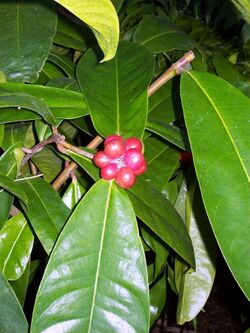Biology:Phaleria octandra
| White daphne | |
|---|---|

| |
| leaves & fruit of Phaleria octandra at Royal Botanic Gardens, Sydney, Australia | |
| Scientific classification | |
| Kingdom: | Plantae |
| Clade: | Tracheophytes |
| Clade: | Angiosperms |
| Clade: | Eudicots |
| Clade: | Rosids |
| Order: | Malvales |
| Family: | Thymelaeaceae |
| Genus: | Phaleria |
| Species: | P. octandra
|
| Binomial name | |
| Phaleria octandra (L.) Baill.
| |
| Synonyms | |
|
Dais longifolia Zipp. ex Span. | |
Phaleria octandra is a flowering plant in the Thymelaeaceae family.[2] It is a shrub found in tropical Australia . It is also naturally found in the New Guinea, Indonesia, Malaysia and the Solomon Islands.
In cultivation it can grow from 3 to 6 metres tall. Leaves are 20 cm long by 7 cm wide, opposite on the stem. White fragrant flowers form from November to February, then they turn brown. Attractive red fruit form from March to April. This plant is a bird attracting.
Suited as a garden plant in tropical situations. Young plants need protection from winds, as well as plenty of shade and moisture.[3]
References
- ↑ Botanic Gardens Conservation International (BGCI).; IUCN SSC Global Tree Specialist Group (2018). "Phaleria octandra". IUCN Red List of Threatened Species 2018: e.T136087348A136089810. doi:10.2305/IUCN.UK.2018-2.RLTS.T136087348A136089810.en. https://www.iucnredlist.org/species/136087348/136089810. Retrieved 20 November 2021.
- ↑ "Phaleria octandra (L.) Baill.". The Trustees of the Royal Botanic Gardens, Kew. n.d.. https://powo.science.kew.org/taxon/urn:lsid:ipni.org:names:832482-1.
- ↑ David L. Jones, Rainforest Plants of Australia. Page 232 ISBN:0-7301-0381-1
Wikidata ☰ Q7180287 entry
 |


